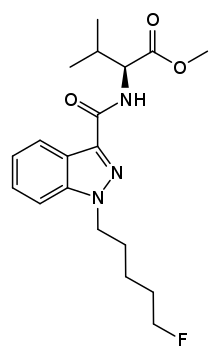5F-AMB
5F-AMB (also known as 5F-MMB-PINACA and 5F-AMB-PINACA) is an indazole-based synthetic cannabinoid from the indazole-3-carboxamide family,[1] which has been used as an active ingredient in synthetic cannabis products. It was first identified in Japan in early 2014.[2][3] Although only very little pharmacological information about 5F-AMB itself exists,[4] its 4-cyanobutyl analogue (instead of 5-fluoropentyl) has been reported to be a potent agonist for the CB1 receptor (KI = 0.7 nM).[5][6]
 | |
| Legal status | |
|---|---|
| Legal status |
|
| Identifiers | |
IUPAC name
| |
| CAS Number |
|
| PubChem CID | |
| ChemSpider | |
| UNII | |
| Chemical and physical data | |
| Formula | C19H26FN3O3 |
| Molar mass | 363.433 g·mol−1 |
| 3D model (JSmol) | |
SMILES
| |
InChI
| |
Side effects
5F-AMB intoxication caused one fatality on its own[7] and another one through ketoacidosis in combination with AB-CHMINACA, AB-FUBINACA, AM-2201, 5F-APINACA, EAM-2201, JWH-018, JWH-122, MAM-2201, STS-135 and THJ-2201 and another fatality in combination with AB-CHMINACA and Diphenidine.[8][9]
Legality
In the United States, 5F-AMB is a Schedule I controlled substance.[10]
5F-AMB is an Anlage II controlled substance in Germany as of May 2015.[11]
Sweden's public health agency suggested classifying 5F-AMB as hazardous substance on November 10, 2014.[12]
The state of Louisiana banned 5F-AMB through an emergency rule after it was detected in a synthetic cannabinoids product called "Kali Berry 2" on 3 June 2014.[13]
5F-AMB is controlled by the Fifth Schedule of the Misuse of Drugs Act (MDA) in Singapore as of May 2015.[14]
5F-AMB was also scheduled in Japan on July 25, 2014.[15]
As of October 2015 5F-AMB is a controlled substance in China.[16]
See also
References
- "5-Fluoro-AMB". Cayman Chemical. Retrieved 22 June 2015.
- Nahoko Uchiyama; Yoshihiko Shimokawa; Maiko Kawamura; Ruri Kikura-Hanajiri; Takashi Hakamatsuka (August 2014). "Chemical analysis of a benzofuran derivative, 2-(2-ethylaminopropyl)benzofuran (2-EAPB), eight synthetic cannabinoids, five cathinone derivatives, and five other designer drugs newly detected in illegal products". Forensic Toxicology. 32 (2): 266–281. doi:10.1007/s11419-014-0238-5.
- Shevyrin V, Melkozerov V, Nevero A, Eltsov O, Shafran Y, Morzherin Y, Lebedev AT (Apr 2015). "Identification and analytical characteristics of synthetic cannabinoids with an indazole-3-carboxamide structure bearing a N-1-methoxycarbonylalkyl group". Analytical and Bioanalytical Chemistry. 407 (21): 6301–15. doi:10.1007/s00216-015-8612-7. PMID 25893797.
- Maria Andersson; Xingxing Diao; Ariane Wohlfarth; Karl B. Scheidweiler; Marilyn A. Huestis (30 April 2016). "Metabolic profiling of new synthetic cannabinoids AMB and 5F-AMB by human hepatocyte and liver microsome incubations and high-resolution mass spectrometry". Rapid Communications in Mass Spectrometry. 30 (8): 1067–107. doi:10.1002/rcm.7538. PMID 27003044.
- Buchler IP et al., INDAZOLE DERIVATIVES. WO 2009/106980
- Banister, Samuel D.; Longworth, Mitchell; Kevin, Richard; Sachdev, Shivani; Santiago, Marina; Stuart, Jordyn; Mack, James B. C.; Glass, Michelle; McGregor, Iain S.; Connor, Mark; Kassiou, Michael (27 July 2016). "Pharmacology of Valinate and tert-Leucinate Synthetic Cannabinoids 5F-AMBICA, 5F-AMB, 5F-ADB, AMB-FUBINACA, MDMB-FUBINACA, MDMB-CHMICA, and Their Analogues". ACS Chemical Neuroscience. 7 (9): 1241–54. doi:10.1021/acschemneuro.6b00137. PMID 27421060.
- Kevin G. Shanks; George S. Behonick (May 2016). "Death after Use of the Synthetic Cannabinoid 5F-AMB". Forensic Science International. 262: e21–e24. doi:10.1016/j.forsciint.2016.03.004. PMID 27017174.
- C. Hess; S. Stockhausen; G. Kernbach-Wighton; B. Madea (August 2015). "Death due to diabetic ketoacidosis: Induction by the consumption of synthetic cannabinoids?". Forensic Science International. 257: e6–e11. doi:10.1016/j.forsciint.2015.08.012. PMID 26363623.
- Koutaro Hasegawa; Amin Wurita; Kayoko Minakata; Kunio Gonmori; Hideki Nozawa; Itaru Yamagishi; Kanako Watanabe; Osamu Suzuki (January 2015). "Postmortem distribution of AB-CHMINACA, 5-fluoro-AMB, and diphenidine in body fluids and solid tissues in a fatal poisoning case: usefulness of adipose tissue for detection of the drugs in unchanged forms". Forensic Toxicology. 33 (1): 45–53. doi:10.1007/s11419-014-0245-6.
- "Schedules of Controlled Substances: Temporary Placement of Six Synthetic Cannabinoids (5F-ADB, 5F-AMB, 5F-APINACA, ADB-FUBINACA, MDMB-CHMICA and MDMB-FUBINACA) Into Schedule I". Drug Enforcement Administration.
- "Gesetz über den Verkehr mit Betäubungsmitteln (Betäubungsmittelgesetz - BtMG) Anlage II (zu § 1 Abs. 1) (verkehrsfähige, aber nicht verschreibungsfähige Betäubungsmittel)" (in German). Retrieved 22 June 2015.
- "Cannabinoider föreslås bli klassade som hälsofarlig vara" (in Swedish). Folkhälsomyndigheten. Retrieved 29 June 2015.
- "DHH Adds Two New Synthetic Marijuana Compounds to Banned List". Louisiana Department of Health and Hospitals. 3 June 2014. Retrieved 22 July 2015.
- "CNB NEWS RELEASE". Central Narcotics Bureau (CNB). 30 April 2015. Archived from the original on 15 July 2015. Retrieved 24 July 2015.
- "指定薬物一覧" (PDF) (in Japanese). Ministry of Health, Labour and Welfare.
- "关于印发《非药用类麻醉药品和精神药品列管办法》的通知" (in Chinese). China Food and Drug Administration. 27 September 2015. Retrieved 1 October 2015.